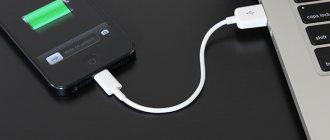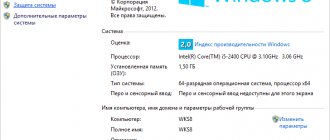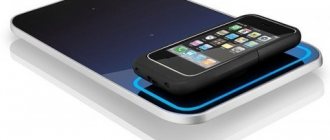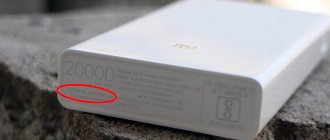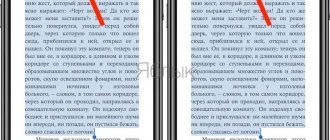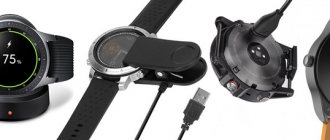To avoid this situation, charge your smartphone when it reaches the 20% mark or earlier. And if the device is completely discharged and turns off, connect it to the network as quickly as possible. If a deep discharge has already occurred and the smartphone does not turn on, connect it to the charger and leave it alone for 1-2 hours. In most cases the battery will recover. Is it possible to interrupt the charging process?
It is possible and even necessary.
Recharging your phone a little does much less harm than completely discharging the battery and then charging it to 100%. If necessary, the device can be charged within 15-20 minutes - this is enough for several hours of battery life. The number of recharges does not affect the battery life and performance. Is overheating a battery harmful?
Very harmful.
If your phone gets hot while charging, it means the batteries are being overloaded. This affects not only the battery life and its capacity, but also the safety of using the smartphone itself. Severe overheating can lead to contact burnout and even fire of the device. If your battery gets very hot, try turning off all apps and switching to Airplane mode. This will reduce the software load, as a result of which the temperature of the gadget should drop. If this method does not help, try replacing the charger or the battery itself. Can smartphones be charged outside?
It is possible, but subject to several conditions:
- Temperature from +10°C to +45°C, preferably +15°C to +35°C;
- Acceptable air humidity.
At low temperatures, the device should not be charged even from a power bank - this will lead to battery wear. And high humidity is dangerous for contacts and can lead to corrosion. If the weather conditions do not meet these conditions, try to go indoors and charge your smartphone there. Why can’t I use a “non-native” charger?
Each smartphone has its own voltage and current requirements.
Therefore, even if the connector for connecting to the network is the same for gadgets from different manufacturers, chargers can interact with the battery differently. If you are using a charger that is not included, read the instructions and determine whether it meets the requirements of your smartphone. If yes, you can use it without any worries. True, it is still advisable to abandon fast charging. All smartphones use their own fast charging technologies, designed with both maximum functionality and battery safety in mind. If the function is used on a smartphone from another manufacturer, it can lead to fatal overheating. How to store an unused smartphone so that the battery does not wear out? Smartphone batteries are subject to aging even when no one uses them. You can reduce the wear rate of your gadget if you keep it turned off with a charge level ranging from 30% to 50%. Storage temperature is also important. Place your smartphone in a cool place with low humidity and a temperature between +10°C and +20°C. Optimal - +15°C. A decrease in battery capacity is inevitable even under such conditions. But if all recommendations are followed, negative changes will begin after a year of storage, while at high temperatures the battery will wear out within a month. What to do if the battery starts to perform worse?
Improper charging often leads to battery problems. Among the main ones are the following:
- The battery began to discharge noticeably faster;
- The charge percentage constantly fluctuates - for example, in a few minutes it “discharges” from 80% to 65%, and then “charges” to 90% without a charger;
- The energy supply during charging is turned off before reaching 100% on its own, and this is not provided by the manufacturer;
- For several hours, even with active use, the same charge percentage is displayed;
- When the device's charge drops to certain values, far from 0% or 1%, it spontaneously turns off, as if it were completely discharged.
In such a situation, calibrating the battery can help. Let's figure out how it works on Android and iOS. How to calibrate the battery on Android?
Google recommends the following method for calibrating your smartphone battery:
- Connect the charger to your smartphone. It is important that the device is turned on.
- Charge your phone for at least 8 hours (even with the fully charged message).
- Unplug the charger and turn off your smartphone.
- Connect the charger to the disconnected smartphone and charge it for an hour.
- Disconnect the charger, turn on the smartphone and keep it on for a few minutes.
- Turn off your smartphone again and charge it for another hour.
After all these manipulations, the battery on your Android device will be calibrated.
Types of chargers – mains, car and induction
- A wall charger is an accessory that allows you to charge devices using electric current directly from an outlet. This means that you can use it not only at home or at work, but wherever you have access to electricity. The USB cable detachable from the power supply allows you to charge the device using the USB port on your computer or laptop.
- A car charger is an accessory that charges devices from the car's cigarette lighter socket. Most often it consists of a power supply that connects directly to the cigarette lighter with a USB output on a cable that has a USB connector on one side and a micro-USB or USB type C on the other. As a rule, it only provides energy when the key is inserted into the ignition.
- An inductive charger is a modern solution that allows you to wirelessly charge devices. The accessory consists of a power cable, as well as a platform on which you place the phone for charging. The charger plugs into an outlet, and when the phone is not in use, it can be placed on the wireless charging platform. When you pick up the phone again, charging will stop.
Inductive charging will work with your smartphone if it is adapted to this technology. The metal back panel prevents the use of induction, unlike the glass body. Wireless charging is only possible with certain models that meet this requirement. You will find information on this topic in the device specification.
A charger with Power Delivery technology is usually a device with a USB Type C connector. Thanks to this, it can be used to charge a phone or laptop at the same time, as long as they have compatible USB C ports. Some charger models also have standard USB 2.0 ports and can be used to charge other mobile devices.
Fast charging standards and compatibility with your phone
We have already mentioned the fast charging mode in passing; it’s time to look into this issue in more detail. The idea of this technology is as follows. After connecting the charger to the smartphone, the latter tells the adapter what current and voltage it requires. If the memory is able to provide these parameters, it issues them. If not, or the smartphone itself does not support fast charging technology, it is produced with standard five volts. In this case, the current, as noted above, will depend on the desires of the mobile device.
But in order for a charger and a smartphone to agree, they must support certain standards. Standards, in turn, depend on the technology used, of which there are quite a lot today. Here are the main ones:
- Quick Charge - from Qualcomm. perhaps the most common standard.
- Pump Express - from MediaTek. The main competitor of Quick Charge.
- Power IQ - from Anker.
- TurboPower - from Lenovo specifically for Motorola smartphones.
- Adaptive Fast Charging - from Samsung.
- VOOC Fast Charging - from BBK specifically for OPPO smartphones.
- Dash Charge is from OnePlus.
- Super Charge - from Huawei.
- Super mCharge - from Meizu.
Thus, when choosing a charger for a smartphone, you need to find out what technology the gadget supports and buy the appropriate one. Otherwise, we will simply throw money away, since most (with some exceptions) technologies are incompatible with each other. If we buy, for example, a charger with Super Charge technology and connect it to a smartphone that does not support this protocol, we will get a regular five-volt charge for quite a lot of money.
Expert opinion
Alexey Bartosh
Specialist in repair and maintenance of electrical equipment and industrial electronics.
Ask a Question
Important! In addition to the protocol itself, it is necessary to pay attention to the version of the technology. Quick Charge, for example, already has five versions that are only compatible from top to bottom. That is, if our smartphone is equipped with Quick Charge 4.0 technology, and the Quick Charge charger is 2.0, then charging will be carried out according to the standard of the lower version. And vice versa. And the lower the version, the less effective fast charging is.
Charger parameters
Once upon a time, each phone manufacturer used solutions suitable only for its devices. Later, by general agreement among manufacturers, most switched to the micro-USB standard to limit the generation of e-waste. Thanks to a single standard, theoretically, a charger from one smartphone can charge any other. You can also use it to replenish energy in your e-reader or camera.
In practice, it is worth paying attention to the characteristics of the charger, such as charging voltage , expressed in volts (V) and current , expressed in amperes (A). As a rule, these parameters are selected so as to effectively and safely charge the device that came with the charger. The mere fact that a charger has an identical micro USB connector does not guarantee that it will reliably charge a phone or reader of another brand.
Yes, you will charge your smartphone faster with a charger with a current of 2A and a voltage of 5V than with a charger with a current of 1A and a voltage of 5V. However, remember that high charging rates reduce battery life.
In most cases, slow charging is more optimal. We are talking, of course, about Li-Ion batteries, which are used in most modern devices. We know, however, that sometimes we don't have enough time to connect our phone to the charger for two hours. Sporadic use of a powerful charger should not harm.
How long does it take to charge different devices?
Each charger maintains its own current and voltage levels, resulting in longer or shorter charging times for devices. Much depends on the type of charger - whether it is a wall charger, a car charger, or a cable connected to the USB port of a laptop. Another variable is the battery capacity of the device being charged. When you add all these elements together, you can even predict the approximate charging time for your device.
Most network chargers for mobile gadgets have a voltage of 5V. The difference lies in the amperage, and the values range from 1 to 2.1 A. The device with the highest amperage will charge faster. Remember, however, that high intensity may cause the battery to overheat. As a rule, both mobile devices and the chargers themselves have protection that turns off the current after the battery is fully charged, however, it is also worth remembering to turn off the phone after the energy level has been restored.
In the case of car chargers , the range is certainly wider: voltage from 3.6 to 20 Volts and current from 0.7A to 4.8A. Remember, however, that higher values are typical for chargers designed to charge multiple devices at the same time. Thus, both the voltage and current strength are “divided” into several ports - from 2 to 5. Which, however, allows for fairly fast charging.
Induction chargers allow you to use a voltage of 5-9 Volts and a current of 1-2A. In a word: they also provide relatively fast charging of devices.
Charging via USB (a cable connected directly to the computer) is a slow option, but also the safest for your device. Of course, a lot depends on the USB standard: 2.0 provides a voltage of 5 Volts and a current of 0.5 A. In the case of USB 3.0 and 3.1, this is already 0.9 A. The latest USB-C standard provides a current of 0.5 A to 3 A.
Charging smartphones: history, facts, myths
Today, the average smartphone flaunts fantastic capabilities.
There is only one thing that upsets me - the battery, which is barely enough for a day of active work! In this post, we'll talk about how and why power supplies in mobile phones have evolved and what fast battery charging technologies are. And at the same time, we’ll dispel a few long-standing myths about the “correct” handling of batteries. Hello, Habr! We are Anker, and this is our first, but not the last post on the habrablog. In case anyone doesn't already know, Anker is the world's largest manufacturer of retail mobile chargers, founded by former Google engineer Stephen Young. However, our portfolio is not limited to chargers alone. The Anker brand produces a variety of USB cables and power banks, headphones and portable speakers, USB hubs, docking stations and even robotic vacuum cleaners! Moreover, all these are our own developments. We do not relabel other people's products. Anker has hundreds of engineers dedicated to the actual research, development and testing of new products. In this blog, we will talk about technologies through the prism of our specialization, sharing knowledge and insights from the international Anker team. We guarantee that you will not find any intrusive advertising or marketing statements here. And right now we’ll take a short excursion into the history of charging mobile phones (our favorite topic). How the first mobile phones were charged, how fast charging technologies work and why it’s time to forget myths about batteries - we’ll tell you here and now.
The history of telephone batteries begins in the distant 1940s, when police cars in St. Louis, PC. Missouri, cordless telephones appeared. They were powered by a car battery, one full charge of which was enough for about six short calls. The car battery was being charged with the car engine turned on. For several decades, mobile phones remained an expensive accessory for premium business-class cars - the electronics of that era were so demanding of current that none of the compact batteries could power it.
The first car radiotelephone, produced in 1946. On the one hand, advanced wireless technologies. On the other hand, rotary dialing. Source: / Wikipedia
This continued until 1973, when the first truly portable Motorola cell phone appeared, which later received the name DynaTAC 8000X (it went on sale only in 1983). The phone was content with a six-cell nickel-cadmium battery with a total capacity of 500 mAh. One charge was enough for 30-40 minutes of conversation (depending on the strength of the signal from the base station).
The charger for the DynaTAC 8000X had a trickle charging function - this is feeding an already charged battery with low currents to compensate for its self-discharge, which is a big problem with nickel-cadmium batteries. It took 10 hours to restore the phone's charge from zero. For the most hasty businessmen, Motorola offered a special fast charger - a docking station weighing 2 kg, which could charge the DynaTAC 8000X battery in just an hour! At the same time, the phone almost did not heat up, and the battery did not degrade. In fact, fast charging of phones did not appear “yesterday”, but 37 years ago.
Motorola's first DynaTAC 8000X portable phone and its optional 2kg fast charger. Source: / Wikipedia, Redfield-1982 / DeviantArt
While mobile phones were mastering new compact nickel-metal hydride batteries in the first half of the 1990s, a real revolution quietly took place in the battery market: in 1991, Sony released the first lithium-ion battery, which came complete with a film video camera CCD-TR1. Lithium-ion batteries were superior to their predecessors in terms of lifespan and energy density. In addition, they did not have a “memory effect”, which finally gave buyers of portable electronics the opportunity to charge their equipment in a new way - without waiting for the battery to be completely discharged and without charging it to the end.
With the advent of lithium-ion batteries, the standby time of phones has increased to days and even weeks versus one or two days previously. The era of “gluttonous” pocket personal computers (PDAs), and especially smartphones, had not yet arrived, so recharging the phone once a week was commonplace - there was simply no need for “fast” charging. But progress did not stand still, and at the end of the 1990s, lithium-polymer batteries went on sale. The first phone with a lithium polymer battery was the legendary Ericsson T28 released in 1999.
Ericsson T28 impressed with its “thinness” - only 15.2 mm in thickness, which was very small at that time. We had a new lithium-polymer battery to thank for this. Source: / Wikipedia
This was not a new type of battery, but only a small upgrade of lithium-ion cells: the liquid electrolyte in them was replaced with a solid or gel-like one, which increased the energy density. But increased energy density made it possible to make thinner batteries with the same capacity. Or more capacious ones in the same sizes. The battery capacity has increased noticeably, but their charging speed has not changed. Most often, smartphones came with the cheapest chargers with an output power of about 5 W, which required up to three hours to replenish the charge of a capacious battery. Even if users bought adapters with a power of 10 W, the power controller of smartphones did not always agree to supply such power to the battery, remaining true to the safe 5 V / 1 A profile. The need to charge a smartphone for an agonizingly long few hours forced the gears of progress to move - in early 2010- In the 1990s, mobile device manufacturers were actively looking for ways to quickly recharge batteries. And yet they found it.
At the end of the twentieth century, it took an average of one and a half to two hours to charge a phone, but mobile phones worked on a single charge for several days. A smartphone with a huge battery capacity of 2000 mAh for the early 2010s could be run down in less than a day - thanks to demanding games, streaming video and fast mobile Internet.
The so-called “slow” charging via USB according to the USB Battery Charging standard allows the charger current to increase to 2 A at a voltage of 5 V, but even two hours to recharge a large smartphone is too long.
Perhaps the most famous power supply for smartphones is the 5-watt charger that comes with the iPhone.
Due to its low power and resulting uselessness, the charger eventually became classified as “electronic waste.” As a result, Apple removed it from the iPhone and Apple Watch. Source: Apple In 2012, the USB Power Delivery standard was adopted, which regulated the transmission of voltages up to 20 V and currents up to 5 A through the USB interface. However, high powers require high-quality certified cables. Based on the Power Delivery specifications, chip manufacturers began to develop their own solutions for fast charging of smartphones. The first to do this was the telecommunications giant Qualcomm, whose Quick Charge 2.0 protocol became an improved version of Power Delivery - unlike its parent standard, Quick Charge 2.0 worked with any Micro-USB 2.0 cables and connectors.
The principle of operation of Quick Charge 2.0 was to gradually supply the battery with increased voltage up to 12 V at a constant current until approximately half of the battery is charged. After this, the voltage drops and the charging speed decreases, which reduces overheating of the smartphone and the battery along with it.
Now the fifth version of Quick Charge is relevant: Qualcomm promises to charge the smartphone up to 50% in 5 minutes and up to 100% in 15 minutes. This is because Quick Charge 5.0 provides for the transfer of power to the smartphone up to 100 W. Moreover, without overheating the battery - the smartphone will warm up no higher than 40 °C.
Qualcomm Quick Charge is a closed, licensed standard. It is supported only by Qualcomm Snapdragon systems-on-a-chip, which, however, powers about 40% of modern Android smartphones. Also, Quick Charge must be supported by the charger. Adding Quick Charge to the power supply has a very small effect on its price. Power supplies with this technology are necessarily marked with a lightning bolt logo, and the charging port itself is highlighted in color.
In Anker PowerPort Speed 5, two connectors support Qualcomm Quick Charge - they are highlighted in blue and accompanied by the technology logo (on the other side of the charger).
Source: Anker Based on Quick Charge, other companies have developed their own, but fully compatible fast charging technologies: Motorola TurboPower, Xiaomi Mi Fast Charging, Samsung Adaptive Fast Charging, Asus BoostMaster and Vivo Dual-Engine Fast Charging. In fact, they are no different from Quick Charge except for names, and therefore work perfectly in tandem with power supplies that support Quick Charge.
In contrast to charging with increased voltage, another approach has earned the right to life - charging batteries with increased currents at a normal voltage of 5 V. For example, the Chinese BBK Electronics, which owns the OPPO brand, followed this path.
VOOC (Voltage Open Loop Multi-step Constant-Current Charging) technology supplies the smartphone with a standard USB voltage of 5 V, but with a current of at least 4.0 A. The third version of VOOC brought support for currents up to 5.0 A, and the fourth version - up to 6.0 A. VOOC under other names came to smartphones of other BBK Electronics brands: OnePlus Dash Charge, Vivo Super FlashCharge and Realme Dart Charge. Small 5 W chargers that come with the iPhone are often not even removed from the box as unnecessary.
The Anker PowerPort III Nano, with similar dimensions, charges the iPhone with a maximum power of 18 W. Source: Anker VOOC and its analogues work in conjunction with special batteries, divided into sectors. A battery supporting this technology has eight contact pads, through which several sectors of one battery are charged in parallel.
Since the charging voltage through VOOC is standard, the phone does not need to reduce it to supply it to the battery, which means the controller will not lower it, generating heat harmful to the battery. That is, from a battery health perspective, VOOC is safer than Quick Charge. Another advantage was that when using the smartphone while charging via VOOC, it does not overheat. But it is better not to use devices with Quick Charge up to version 5.0 while charging, otherwise the smartphones begin to heat up and the power controller, for safety reasons, reduces the voltage and slows down charging.
VOOC looked too good until the user learned that the technology requires a special cable with thicker cores to carry high currents and an additional signal pin on the connector.
For the OPPO VOOC fast charging technology and its analogs to work, you need such a non-standard cable. Cables with a USB-C plug instead of Micro-USB 2.0 also have an additional pin. Source: AliExpress
As you understand, included chargers for smartphones always support one fast charging technology (well, and its “copies”). If you are the lucky owner of gadgets from different companies, for example, Apple iPad Pro with Power Delivery, Samsung GALAXY S9 with Adaptive Fast Charging, then charging from one gadget will charge another gadget in slow mode.
For a “zoo” of devices from different brands, it is useful to buy one universal adapter with several outputs for simultaneous charging of all gadgets - such that the charger understands which fast charging standard the connected gadget works with and starts charging according to this standard.
Here's a reminder for you.
This table contains the specifications of the most popular smartphone fast charging technologies in comparison with all USB versions. Source: Anker In all Anker chargers, Anker PowerIQ technology is responsible for this. For example, the Anker PowerPort Atom III has USB-C and USB-A outputs, each marked with PowerIQ 3.0 and PowerIQ 2.0, respectively. You can connect smartphones, tablets and even laptops with support for USB Power Delivery, Qualcomm Quick Charge and their analogues to these outputs - in all cases the adapter will select the maximum allowable power mode, be it 5 V / 2.4 A, 9 V / 2 A or even 12 V / 1.5 A.
Anker Powerport III Nano 20W can become an indispensable assistant in this case. This is the thinnest and lightest charger in the Anker line. The new product will fit almost any Apple and Android device and eliminate the need to have a personal memory for each gadget. It features one single USB-C port that can deliver up to 20W of power using the Power Delivery standard. Anker Innovations engineers fit 20W into an adapter measuring 2.74 x 3.00 cm, which is comparable to the size of a 5 ruble coin.
Each Anker charger with PowerIQ technology contains a chip that communicates with the connected gadget and selects the most efficient power protocol for it. For example, PowerIQ 3.0 works with Power Delivery, Quick Charge and Apple Fast Charging. When a smartphone is connected, the PowerIQ chip sends commands that offer the smartphone one by one supported power protocols. If the smartphone responds that it can work with Power Delivery or Quick Charge, the Anker charger transmits data about the supported output voltage and current. The smartphone will select the optimal power mode from those offered and send a command about it to the charger. After this, the Anker charger will regulate the voltage in accordance with the selected profile, and the smartphone will consume current in accordance with the protocol.
Anker PowerPort Atom III can charge either a smartphone or a laptop, and at the highest possible speed.
The USB-C output supplies 45 W, and the USB-A output supplies 15 W, simultaneously. Source: Anker Smartphone users are still arguing on the Internet about the dangers of fast charging for batteries. Some argue that any deviation from the years-proven combination of 5 V / 2 A (10 W) harms the battery, others cite the results of studies proving that supplying the phone with even 30 W of power, if it affects the health of the battery, is extremely insignificant . We will now mercilessly destroy this and several other myths about charging batteries.
Of course, high charge and discharge currents are not good for batteries. But should you be afraid of charging your gadget in this way, or will the negative effect of this, if it does appear, appear closer to the end of the life of the smartphone itself? Daily charging in the most gentle mode (5 V / 1 A) will reduce the capacity of the lithium-polymer battery by approximately 10-15% over 400 cycles, which corresponds to one to one and a half years of using the device. Upon reaching 500 cycles, it is recommended to change the phone battery, since as the battery ages, the capacity of the battery decreases not linearly, but exponentially.
The effect of fast charging on battery wear was tested by specialists at the SLAC National Accelerator Laboratory (a laboratory at Stanford University) back in 2014. The results of the study showed that the state of the anode and cathode does not change depending on the charging rate of the battery. In 2022, DDay.it staff conducted a stress test for the OPPO Find X2 Pro smartphone with VOOC technology. For a month and a half, the phone was charged with a 65 W adapter; during the test, the battery survived 248 cycles. To quickly discharge the phone, an artificial maximum load was created, from which the device heated to a harmful 44 °C. At the end of the experiment, the battery lost about 15% of its capacity, although it was initially assumed that the degradation would be up to 35%. If it were not for high loads and dangerous temperatures for the battery, the drop in capacity would be even less.
It’s surprising that even in 2022, old myths about “correct” charging are still circulating among inexperienced smartphone users. For example, some people still "boost" the battery after purchasing a phone, charging the device to full several times and discharging it to zero, as was recommended in the early 1990s for nickel-metal hydride cells. This supposedly helps to use the full capacity of the new battery, and if this is not done, then the smartphone will supposedly discharge earlier than it should. Some also call this process "power controller calibration".
In fact, lithium-ion batteries do not need any “training” before using the device; several cycles of full charging and discharging will not affect the battery capacity at all and will not increase the possible battery life by a minute. The controller knows very well what capacity it has to work with, and besides, sometimes it itself, without user intervention, carries out calibration as the battery degrades.
Excerpt from the instructions for Motorola StarTAC.
It clearly states that the nickel-metal hydride battery must be “boosted” before use. The phone was also equipped with lithium-ion batteries, but there is not a word in the instructions about their “boosting.” The legend about the importance of “boosting” batteries still feeds the myth of the memory effect. The memory effect itself, when the capacity of an element is lost due to frequent recharging of an incompletely discharged battery, does exist. But both early lithium-ion and modern lithium-polymer batteries practically do not have this effect (its manifestation is negligible). Outdated nickel-cadmium and, to a lesser extent, nickel-metal hydride batteries, which have not been used in gadgets since the late 1990s, are susceptible to the memory effect.
The memory effect occurs due to the enlargement of the crystals of the working substance of a nickel-cadmium battery.
The larger the crystals, the smaller the total surface area. The smaller the area, the smaller the battery capacity. In lithium-ion batteries, crystal enlargement does not occur. The schematic image shows a healthy electrode on the left and an electrode with grown crystals on the right. Source: Anker The third myth says that smartphones should not be left connected to the charger for a long time, for example, overnight - as if the battery is overcharged, causing it to lose capacity and even catch fire. In principle, in the early 1990s, such an opinion still had a right to life, but now, in the era of lithium-ion batteries with controllers, it makes no difference at all how long you keep your smartphone connected to the outlet. Then a power controller was invented to prevent overcharging. When the battery is charged, the controller sees this and goes into charge saving mode, reducing the current consumption to near-zero values.
The capacity of mobile phone batteries has literally increased by an order of magnitude over the past quarter century, as has the “appetite” for gadgets. Progress in batteries is not as fast as in the field of graphics processors or memory, but the current lithium-polymer batteries are a real miracle that only require high-quality power.
To unlock the full potential of the battery and enjoy safe and fast charging, you should choose a good charger - the included smartphone adapters, to save money, most often meet only the minimum requirements for charging. It is doubly wise to have a multiport universal charging unit at home that works with several fast charging protocols and has USB-A and USB-C outputs for the most modern and aging equipment.



